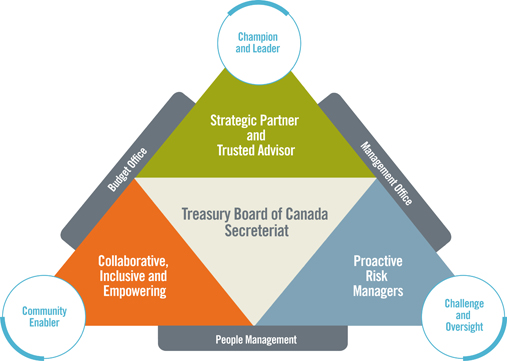Common menu bar links
Breadcrumb Trail
Institutional links
Expenditure Management
Departmental Performance Reports
2011-12
Organizational Overview
Analysis of Programs by Strategic Outcome
Supplementary Information
ARCHIVED - Treasury Board of Canada Secretariat - 2011-12 Departmental Performance Report
 This page has been archived.
This page has been archived.
Archived Content
Information identified as archived on the Web is for reference, research or recordkeeping purposes. It has not been altered or updated after the date of archiving. Web pages that are archived on the Web are not subject to the Government of Canada Web Standards. As per the Communications Policy of the Government of Canada, you can request alternate formats on the "Contact Us" page.
Raison d'�tre
The Treasury Board of Canada Secretariat (the Secretariat) is the administrative arm of the Treasury Board. It supports Treasury Board ministers and strengthens the way government is managed. In this way, the Secretariat helps ensure value for money in government spending and results for Canadians.
Responsibilities
Treasury Board Roles
The Treasury Board is a Cabinet committee of ministers established in 1867. It oversees the government’s financial, human resources and administrative responsibilities, and establishes policies that govern each of these areas. In addition, the Prime Minister has designated the Treasury Board to act as the committee of the Queen’s Privy Council with respect to the consideration and approval of regulations and most orders-in-council. The Treasury Board, as the Management Board for the government, has three principle roles:
- It acts as the government’s Management Office by promoting improved management performance. It also approves policies to support the prudent and effective management of the government’s assets and financial, information, and technology resources.
- It acts as the government’s Budget Office by examining and approving the proposed spending plans of government departments and by reviewing the development of approved programs.
- It acts as the human resources office and the employer or People Management Office by managing compensation. It also sets people management policies (including determining the terms and conditions of employment) to ensure coherence and consistency, where needed.
The Secretariat makes recommendations and supports the Treasury Board in each of its roles. It provides advice on policies, directives, regulations and program spending to promote sound management of government resources. The Secretariat also provides leadership and guidance on management functions within departments and agencies, while respecting the primary responsibility of deputy heads See footnote [1] in managing their organizations and their roles as accounting officers before Parliament.
Within the Secretariat, the Comptroller General of Canada provides government-wide leadership, direction, oversight and capacity building for financial management, internal audit and the management of acquired services and assets.
The Chief Human Resources Officer leads people management across the core public administration by developing workplace and workforce policies and programs; by centrally managing labour relations, compensation, and pension and benefit plans; and by developing executive leadership.
The Chief Information Officer provides government-wide leadership, direction, oversight and capacity building for information management (IM), information technology (IT), government security (including identity management), and access to information, privacy, and internal and external service delivery.
The Treasury Board Portfolio is made up of the Secretariat and the Canada School of Public Service. The Public Service Pension Investment Board, the Office of the Commissioner of Lobbying of Canada, and the Office of the Public Sector Integrity Commissioner of Canada are arm's-length organizations whose reports to Parliament are tabled by the President of the Treasury Board.
The Secretariat is guided by its vision statement, “Better government: with partners, for Canadians.” When working with federal departments, agencies and Crown corporations, the Secretariat plays three central agency roles:
- An enabling role to help organizations improve management performance;
- An oversight role that includes developing policies and standards, and reporting on the government's overall management and budgetary performance; and
- A leadership role in driving and modelling excellence in public sector management.
In recent years, through legislation such as the Federal Accountability Act as well as through the renewal of the suite of Treasury Board policies, greater emphasis has been placed on the Secretariat's enabling role—helping deputy heads maximize their flexibility to achieve management excellence within their organizations.
The following diagram shows how the Secretariat works with organizations to fulfill its three central agency roles, and how it supports the Treasury Board.
Figure 1: How the Secretariat Works With Organizations

Figure 1: How the Secretariat Works with Organizations - Text version
